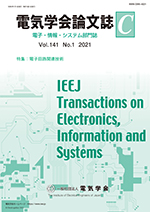
- |<
- <
- 1
- >
- >|
-
Motoshi Tanaka, Takuaki Yajima, Yoshitsugu Niiyama2021Volume 141Issue 6 Pages 720-726
Published: June 01, 2021
Released on J-STAGE: June 01, 2021
JOURNAL RESTRICTED ACCESSEye movement was measured when food and wear pictures that consisted of four items with different positions were subjectively evaluated by seven-grade scale (like - dislike), and the relationship between the subjective evaluation and feature parameters obtained from eye fixation and scanpath was investigated. In results, a significant relationship between the saliency of pictures obtained by GBVS and the normalized total fixation time was not observed. And the eye movement at the initial state might be similar, independent of the saliency of items in the pictures. The fixation time to the item of the negative `dislike' evaluation became relatively longer, when the evaluation was negative irrespective of the experimental condition. These feature parameters would be useful for quantifying the evaluation of the pictures.
View full abstractDownload PDF (2133K)
-
Xiaoyan Zhang, Atsumi Ohara2021Volume 141Issue 6 Pages 727-734
Published: June 01, 2021
Released on J-STAGE: June 01, 2021
JOURNAL RESTRICTED ACCESSThe static output-feedback controller synthesis problem is investigated in this paper for linear MIMO positive delay systems. The objective is to construct a static output-feedback controller such that the closed-loop system is positive, asymptotically stable, and the L1-gain from the exogenous input to the regulated output is minimized. For the MIMO positive systems without delay, the necessary and sufficient condition for the existence of the controller is derived. Meanwhile, the new sufficient condition for the design of the controller of the MIMO positive systems with delay has been given. The condition in this paper breaks the limitations of existing methods in the literature where, for example, the state-space equation has a specific form, etc. Furthermore, the control gain can be easily obtained by linear programming (LP) approach. Several numerical experiments are carried out to illustrate the proposed results.
View full abstractDownload PDF (1277K)
-
Daisuke Fukui, Takushige Katsura, Masashi Egi, Norihisa Komoda2021Volume 141Issue 6 Pages 735-742
Published: June 01, 2021
Released on J-STAGE: June 01, 2021
JOURNAL RESTRICTED ACCESSA method for estimating human emotions using a lightweight fNIRS device is proposed. In the proposed method, from only 2ch sensors total-hemoglobin data measured by the lightweight fNIRS device, 35 features for estimating emotions are generated. Using generated features, K-Nearest Neighbor model for estimating pleasant / unpleasant emotions are constructed. The evaluation of the constructed models using measured 320 data from 20 subjects shows that it is possible to estimate the emotions with more than 80% recall by cross-validation.
View full abstractDownload PDF (1022K)
-
Susumu Kawai, Tomotaka Wada, Hiroyuki Ebara2021Volume 141Issue 6 Pages 743-751
Published: June 01, 2021
Released on J-STAGE: June 01, 2021
JOURNAL RESTRICTED ACCESSThis paper proposes a method for obtaining the Flight Time of Small Aircraft from acceleration using a 3-axis acceleration sensor with a built-in Smartphone. In recent years, the use of GNSS(Global Navigation Satelite System) has been successful, and it was listed as a candidate this time, but there are some errors and there is a history of giving up. The conventional method had many individual errors because it is recollected by the Captain. The proposed method can be easily and inexpensively upgraded. In the experiment, an actual Small Aircraft was used and acceleration data was acquired assuming actual flight. We were able to fly 5 times because we could not fly freely due to control. Excel and total software R were used for data analysis. The number of flight was 5, but the number of samples was more than 30,000 in one flight. Since the phenomena in the natural world follow a normal distribution, we calculated the threshold with a 99% confidence interval. R was used for curve analysis of the normal distribution. As a result, it was found that false detection occurred at a rate of 0.5% in the proposed method.
View full abstractDownload PDF (875K)
-
Rentaro Ono, Hiroki Takada2021Volume 141Issue 6 Pages 752-753
Published: June 01, 2021
Released on J-STAGE: June 01, 2021
JOURNAL RESTRICTED ACCESSIt is thought that the control system for stereoscopic vision differs between young and elderly individuals. In this study, the authors focused on the differences in eye movements among ages while viewing 3D video clips. The results showed that for the young, eye movements were significantly higher while tracking a visual target than during peripheral viewing of a 3D video clip. However, no significant difference was observed among the elderly. It was suggested that the amplitude of the fixation eye movement increased in the elderly because the visual processing ability in the peripheral vision declined with advancing age.
View full abstractDownload PDF (336K)
-
2021Volume 141Issue 6 Pages NL6_1-NL6_2
Published: June 01, 2021
Released on J-STAGE: June 01, 2021
JOURNAL FREE ACCESSDownload PDF (294K) -
2021Volume 141Issue 6 Pages NL6_3-NL6_4
Published: June 01, 2021
Released on J-STAGE: June 01, 2021
JOURNAL FREE ACCESSDownload PDF (247K)
-
2021Volume 141Issue 6 Pages L6_1
Published: June 01, 2021
Released on J-STAGE: June 01, 2021
JOURNAL FREE ACCESSDownload PDF (427K)
- |<
- <
- 1
- >
- >|